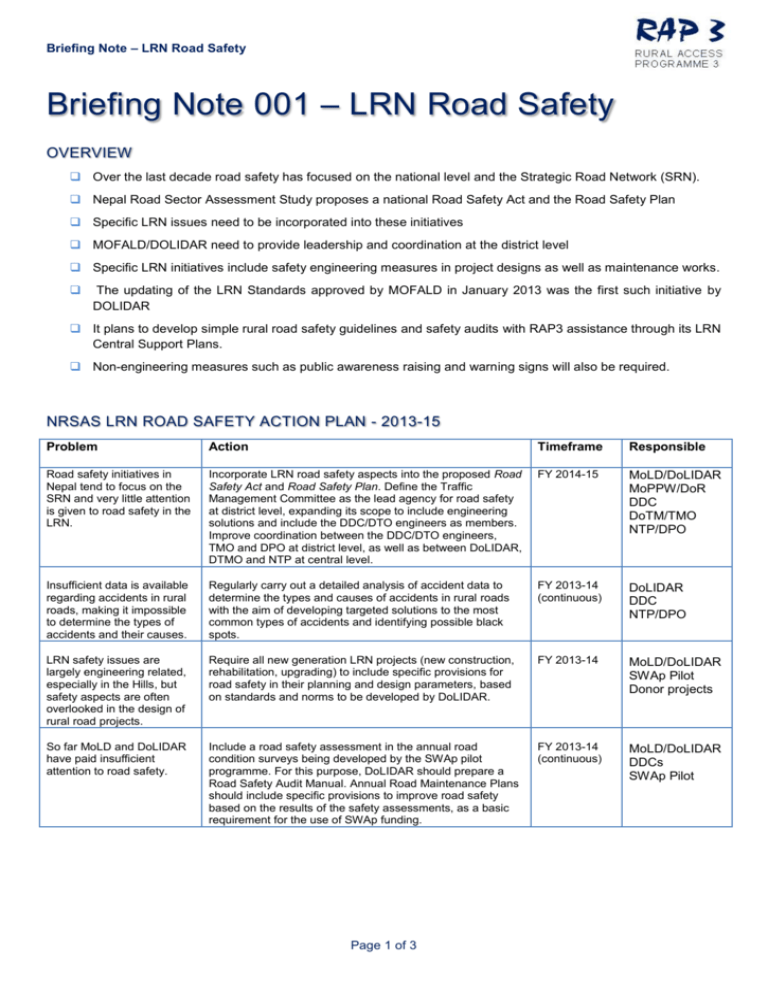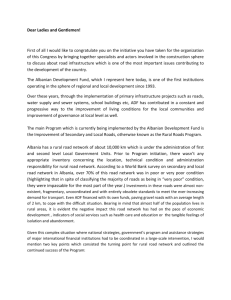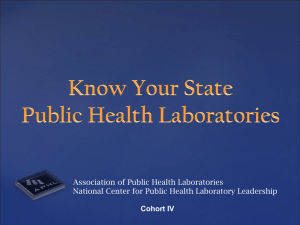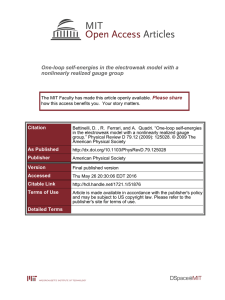this document - Rural Access Programme
advertisement

Briefing Note – LRN Road Safety Briefing Note 001 – LRN Road Safety OVERVIEW Over the last decade road safety has focused on the national level and the Strategic Road Network (SRN). Nepal Road Sector Assessment Study proposes a national Road Safety Act and the Road Safety Plan Specific LRN issues need to be incorporated into these initiatives MOFALD/DOLIDAR need to provide leadership and coordination at the district level Specific LRN initiatives include safety engineering measures in project designs as well as maintenance works. The updating of the LRN Standards approved by MOFALD in January 2013 was the first such initiative by DOLIDAR It plans to develop simple rural road safety guidelines and safety audits with RAP3 assistance through its LRN Central Support Plans. Non-engineering measures such as public awareness raising and warning signs will also be required. NRSAS LRN ROAD SAFETY ACTION PLAN - 2013-15 Problem Action Timeframe Responsible Road safety initiatives in Nepal tend to focus on the SRN and very little attention is given to road safety in the LRN. Incorporate LRN road safety aspects into the proposed Road Safety Act and Road Safety Plan. Define the Traffic Management Committee as the lead agency for road safety at district level, expanding its scope to include engineering solutions and include the DDC/DTO engineers as members. Improve coordination between the DDC/DTO engineers, TMO and DPO at district level, as well as between DoLIDAR, DTMO and NTP at central level. FY 2014-15 MoLD/DoLIDAR MoPPW/DoR DDC DoTM/TMO NTP/DPO Insufficient data is available regarding accidents in rural roads, making it impossible to determine the types of accidents and their causes. Regularly carry out a detailed analysis of accident data to determine the types and causes of accidents in rural roads with the aim of developing targeted solutions to the most common types of accidents and identifying possible black spots. FY 2013-14 (continuous) DoLIDAR DDC NTP/DPO LRN safety issues are largely engineering related, especially in the Hills, but safety aspects are often overlooked in the design of rural road projects. Require all new generation LRN projects (new construction, rehabilitation, upgrading) to include specific provisions for road safety in their planning and design parameters, based on standards and norms to be developed by DoLIDAR. FY 2013-14 MoLD/DoLIDAR SWAp Pilot Donor projects So far MoLD and DoLIDAR have paid insufficient attention to road safety. Include a road safety assessment in the annual road condition surveys being developed by the SWAp pilot programme. For this purpose, DoLIDAR should prepare a Road Safety Audit Manual. Annual Road Maintenance Plans should include specific provisions to improve road safety based on the results of the safety assessments, as a basic requirement for the use of SWAp funding. FY 2013-14 (continuous) MoLD/DoLIDAR DDCs SWAp Pilot Page 1 of 3 Briefing Note – LRN Road Safety LEGISLATIVE AND INSTITUTIONAL FRAMEWORK Current legislation: Motor Vehicle and Transport Management Act (1993) and Motor Vehicle and Transport Management Regulations (1997) for rules and enforcement; the Public Roads Act (1974) and the Nepal Rural Road Standards (2010) regarding technical standards for rural roads; the Local Self Governance Act (1999) and the Roads Board Regulations (2004) define institutional responsibilities for implementing and funding safety measures in the LRN. Institutionally, the Department of Traffic Management (DoTM) under the Ministry of Labour and Transport Management (MoLTM) for vehicles and traffic, the Nepal Traffic Police (NTP) for enforcement and Transport Management Committees (TMC) at district level. TMC are chaired by the Chief District Officer, with the Chief of the Transport Management Office (TMO) as Secretary. Members include the Chief of the District Police Office (DPO) and transport entrepreneurs and workers and Department of Roads (DoR) for technical know-how. The District Development Committee (DDC) and District Technical Office (DTO) engineers responsible for implementing road safety engineering measures are not included as members. RURAL ROAD SAFETY Twenty years of SRN road safety activity, (collection of accident data, planned maintenance to reduce accidents a signature to the Moscow Declaration (2009) and United Nations Economic and Social Commission for Asia and the Pacific (UNESCAP) Road Safety Goals of Asia and the Pacific 2007-2015 (2007) and has developed a Road Safety Business Plan (2010) In stark contrast, virtually nothing comparable has been carried out on road safety in the LRN, either by DoLIDAR or donor-funded rural road projects (e.g. DRILP, DRSP, RAIDP, RAP and RRRSDP). A specific analysis of the degree and characteristics of rural road accidents is necessary to identify the type of safety issues in rural roads interventions required for LRN. the rapid development of the LRN network and the traffic that makes use of it is beginning to stimulate interest in LRN road safety issues, although there is not yet much sense of direction or strategic thinking. GENERAL LRN SAFETY INITIATIVES NRSAS recommends designation of a lead agency to coordinate road safety issues, the formulation of a specific Road Safety Act, the development of a Road Safety Plan and a combined strategy for the LRN and SRN, to drive institutional and management functions for LRN road safety and prevent LRN becoming the “poor cousin” in terms of funding and resources Expand the Transport Management Committee scope to encompass road safety in general Include the DTO/DDC engineers as members to ensure proper coordination between traffic management and engineering aspects of road safety. Include safety issues specific to the LRN in the Road Safety Act. DoLIDAR to develop a specific Road Safety Plan for the LRN, which may form the input for the national level Road Safety Plan, as part of Rural Transport Infrastructure Sector Wide Approach Use of internet-based IRAP/gTKP Road Safety Toolkit. Improve capacities and resources DDC/DTO engineers, the TMO and the DPO at district level and DoLIDAR, DTMO and NTP at central level. Page 2 of 3 Briefing Note – LRN Road Safety SPECIFIC LRN SAFETY INITIATIVES Road and terrain conditions play a major role, especially in the Hills. A detailed analysis of the accident data for rural roads would help identify the main causes of accidents in these roads, and allow a specific approach to be developed for the LRN Engineering solutions will form an important aspect of road safety improvement. Examples include Danger Unstable slopes resulting in material falling onto the road or the road itself becoming unstable. Solution Stabilize the slopes by means of bioengineering, retaining walls and other engineering solutions. Often the road width is decreased, making it hazardous for vehicles to pass. Flowing water and seasonal flooding form serious hazards to rural roads, deteriorating the road surface and causing washouts. Road surfaces of unpaved roads are slippery, especially during rains. In the Hills, many roads are bordered by steep and precarious slopes, resulting in more significant injuries and even fatalities in case of accidents. Adopt new LRN standards for up grading and new construction Create proper lateral and cross drainage to ensure water is guided safely away from the road without causing damage. Apply suitable surface material, especially in hazardous road sections (steep gradients, sharp curves). Place gabion safety barriers and confidence blocks in dangerous sections. All rural road projects to be required to make specific provisions for road safety in their designs. Guidelines for road safety improvement in rural roads are required to assist district engineers in this process, and it is strongly recommended that DoLIDAR develop such guidelines with assistance from the SWAp Maintenance Pilot. These guidelines should focus on simple safety interventions, using locally available resources and commonly used techniques to reduce costs and facilitate implementation. Another obvious and immediate way of targeting LRN road safety is through remedial works related to the maintenance and repair of existing roads. Proper maintenance will result in better road conditions and safer roads. This may relate to improving the road surface to make roads easier and safer to travel on, but also to aspects such as cutting roadside vegetation to improve visibility. The scope of annual maintenance interventions should furthermore be expanded to specifically include safety aspects. This should include an initial road safety assessment that may be combined with the annual road condition surveys that are currently being promoted by the SWAp programme. This is also in line with the procedures of RBN, where Annual Road Maintenance Plans (ARMP) are required to include safety measures. A simple Road Safety Audit Manual is required to assist district engineers in carrying out such annual road safety assessments, and should be developed by DoLIDAR with assistance from RAP3 NON ENGINEERING INITIATIVES This involves enforcement of existing traffic rules and other legislation regarding vehicle condition, permits and licenses, overloading and driver behaviour. It also includes increasing awareness on road safety among the general public, the identification of dangerous road sections through the placement of warning signs, and the closure of slippery roads during rains. While the DTO and DDC engineers play an important role in applying engineering solutions, the District Police Office and the Transport Management Office will need to ensure the enforcement of non-engineering solutions Page 3 of 3






